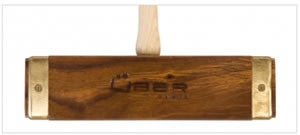History of the Game of Croquet
History of Croquet
The beginnings of croquet are unclear – with evidence of similar games dating back hundreds of years. There are stories from up to 800 years ago of games placed with balls, hoops and sticks. A Dutch game from the mid 1600’s which is still played today is could be part of the croquet heritage. Played with metal ring, and wooden balls, the equipment is relatively similar. Another game, termed Pall Mall (or variations thereof!) has also been documented as being played in France. With mallets and smaller wooden balls, there seems to be a striking resemblance to current croquet sets. This was also played in London according to Samuel Pepys.
Evidence is sketchy at best, and only in the mid 1800’s did croquet start appearing again. Credit is given to the Jaques family for introducing it into the UK, even though they first saw a new game called Crookey being played in Ireland which they brought to the UK. The Jaques family were supplying sporting goods to the middle class at this stage, and had successfully cornered this market, allowing croquet to reach a very captive audience.
At this stage croquet was a very new game, and if it were not were for Walter James Whitmore, it may well have never become as popular as it is today. Whitmore was a failed poet, novelist and inventor, but threw himself into croquet and developed the strategy, tweaked the rules, wrote a guide with tactics and was an instrumental part of croquets first open tournament. Incidentally, he also became the first champion!
All England Croquet Club
The game of croquet spread across the South of England, particularly along the coast, where Whitmore was based. The first club to be set up was at Worthing, in West Sussex in 1860. Following the formation of these croquet clubs, a national centre in London was founded – the All England Croquet Club at Wimbledon. Unfortunately, controversy soon took hold, with Whitmore setting up a rival organisation called the National Croquet Club. Although this organisation did finally merge with the All England Croquet Club, Whitmore continued to cause fractures, and set up another rival croquet organisation, which was wound down when he passed away in 1872.
Around this time a new game was also appearing, which soon overtake croquet in both popularity and prevalence. Lawn tennis was given some space at Wimbledon and it rapidly took over, as croquet became less and less popular. Soon the headquarters were rebranded as the All England Croquet and Lawn Tennis Club, and around 10 years later (1882), croquet was removed from the name altogether.
Development of Croquet
Although tennis almost caused the demise of the game of croquet, and it’s popularity significantly waned, it proved a resilient game, and a resurgence occurred in the 1920’s, after the first World War. With the introduction of more clubs, a growing middle class, the game began to be played more and more. As had happened before though, the Second World War was to once again nearly bring about the demise of the game. This time many croquet clubs were forced to close. As a game of leisure for the middle class, croquet has been at risk numerous times - but each time, in the following decades has seen a significant revival.
1962 saw a group of undergraduate compete in a croquet tournament which arguably turned the corner for croquet. Traditionally a game for older people, this interest from younger people generated a completely new interest and enthusiasm.
It was only relatively recently that the latest resurgence saw the increased influence of the Croquet Association, to provide a central co-ordination and umbrella organisation for all the croquet clubs around the country. Currently based at Cheltenham Croquet Club where many croquet events are held, it was relocated here from the Hurlingham Club in London.
Croquet Internationally
As croquet had come to Britain whilst it still had an empire, the game quickly spread to the colonies, with New Zealand and Australia in particular taking a keen interest.
New Zealand saw its first croquet club formed in 1879, with the Canterbury Association soon following in 1910, made necessary as the number of clubs grew. The New Zealand Open Championship which was first held in 1913 was an overriding success, and ultimately this all led to the formation of the New Zealand Croquet Council in 1920. Unaffected by the war in Europe, membership and interest flourished, and it soon became more popular than it was in England. In recent times the game of croquet has maintained its popularity and it continues to flourish in New Zealand.
Australia saw a similar growth in interest of croquet – with clubs and associations forming in the begin 1900’s. 1925 saw the first test matches played between England and Australia. A trophy donated by MacPherson Robertson gave rise to the MacRobertson shield which is to this day keenly contested between various nations.
Equality in Croquet
In New Zealand Croquet was from the offset also played by women. As the clubs were traditionally associated with bowls clubs which banned women from playing, many turned to Croquet as a game which they could enjoy and compete in on a level footing to men. As bowls opened up to women in the middles of the twentieth century, the croquet membership dwindled. It was a couple of decades later that this trend of female membership started reversing and croquet once again became more popular with women.
Croquet in Australia has mainly been played by women - in the 1980’s nine tenth of the players were women, with many of them falling into the middle age and older demographic. Similar to New Zealand, bowls was prohibited for women, which led them to turn to croquet. Although the balance between men and women is returning the majority of the players who compete are men.
- Andre Boeke



